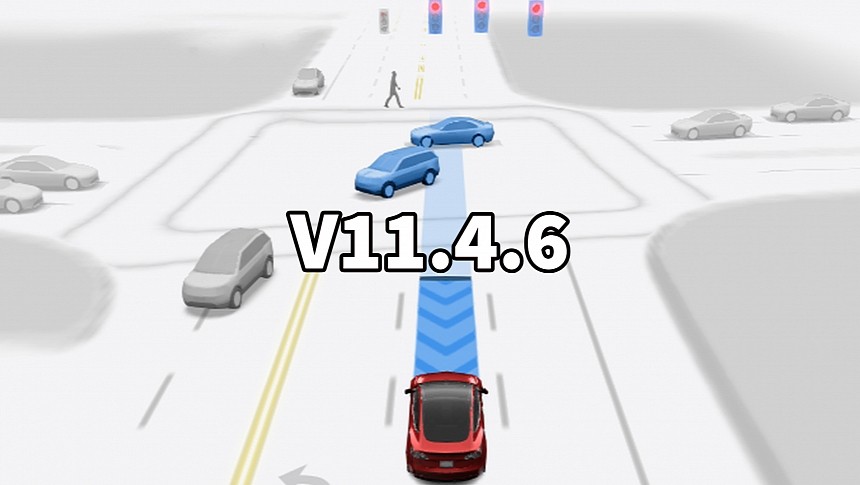Tesla continued the development of its Full Self-Driving Beta software, although the latest builds did not make it to customers' vehicles. FSD Beta V11.4.6 was pushed to employees' cars on Friday, and we still don't know if it will see a wider rollout. The most important addition is reducing the unnecessary slowdowns, which many people started calling "phantom braking."
After a rapid development pace this spring, FSD Beta is advancing much more slowly in July. It could be the heat that hinders development or simply the summer season with most developers going on vacation, but we haven't seen a new build in over a month. The FSD Beta V11.4.4 was released in mid-June, and no other build has been deemed production-ready to be sent to customers' cars since then. On July 8, Tesla pushed V11.4.5, mainly containing bug fixes, to employees, but this version didn't make it into production.
Another internal build was sent on July 21 to Tesla employees, and people hoped it would see wider adoption. Until now, nothing happened on this front, so we're still waiting to see if Tesla will offer the update to more cars outside the inner circle of testers. The V11.4 builds are already reserved for advanced users, being more cutting-edge than the older V11.3.6 that has recently been included with most Tesla software updates.
Tesla stopped offering the full release notes for its software, so it's unclear what are the new things introduced in the latest update. Based on a Not a Tesla App report, the software brings bug fixes and improvements to the Automatic Emergency Braking (AEB) system. More specifically, Teslas on the latest build will be able to apply automatic emergency braking on all objects recognized by Occupancy Network, not just vehicles. This should offer increased safety around vulnerable road users (VRUs) and other objects.
There's another addition in this software version, as Elon Musk revealed on Twitter (or, should I say, the X app). Tesla's CEO claims this version should reduce the number of "unnecessary slowdowns," which is another way of saying "phantom breaking." This is an undocumented change, so there's no confirmation about it other than Musk's words. People have been complaining about phantom braking for more than a year and any improvements in this area are more than welcome. Tesla is yet to explain what's been causing phantom braking.
At least one crash was proven to have been caused by phantom braking. In November 2022, a Tesla Model S driving on I-80 on Bay Bridge abruptly slowed down after moving into the fast lane. This caused a pileup crash involving eight vehicles, with nine injured, including a two-year-old child. The impact was caught on camera, showing this was a classic case of phantom braking. The investigation revealed in January that the driver had activated FSD Beta moments before the car braked suddenly.
Another internal build was sent on July 21 to Tesla employees, and people hoped it would see wider adoption. Until now, nothing happened on this front, so we're still waiting to see if Tesla will offer the update to more cars outside the inner circle of testers. The V11.4 builds are already reserved for advanced users, being more cutting-edge than the older V11.3.6 that has recently been included with most Tesla software updates.
Tesla stopped offering the full release notes for its software, so it's unclear what are the new things introduced in the latest update. Based on a Not a Tesla App report, the software brings bug fixes and improvements to the Automatic Emergency Braking (AEB) system. More specifically, Teslas on the latest build will be able to apply automatic emergency braking on all objects recognized by Occupancy Network, not just vehicles. This should offer increased safety around vulnerable road users (VRUs) and other objects.
There's another addition in this software version, as Elon Musk revealed on Twitter (or, should I say, the X app). Tesla's CEO claims this version should reduce the number of "unnecessary slowdowns," which is another way of saying "phantom breaking." This is an undocumented change, so there's no confirmation about it other than Musk's words. People have been complaining about phantom braking for more than a year and any improvements in this area are more than welcome. Tesla is yet to explain what's been causing phantom braking.
At least one crash was proven to have been caused by phantom braking. In November 2022, a Tesla Model S driving on I-80 on Bay Bridge abruptly slowed down after moving into the fast lane. This caused a pileup crash involving eight vehicles, with nine injured, including a two-year-old child. The impact was caught on camera, showing this was a classic case of phantom braking. The investigation revealed in January that the driver had activated FSD Beta moments before the car braked suddenly.
Reduces unnecessary slowdowns
— Elon Musk (@elonmusk) July 22, 2023






